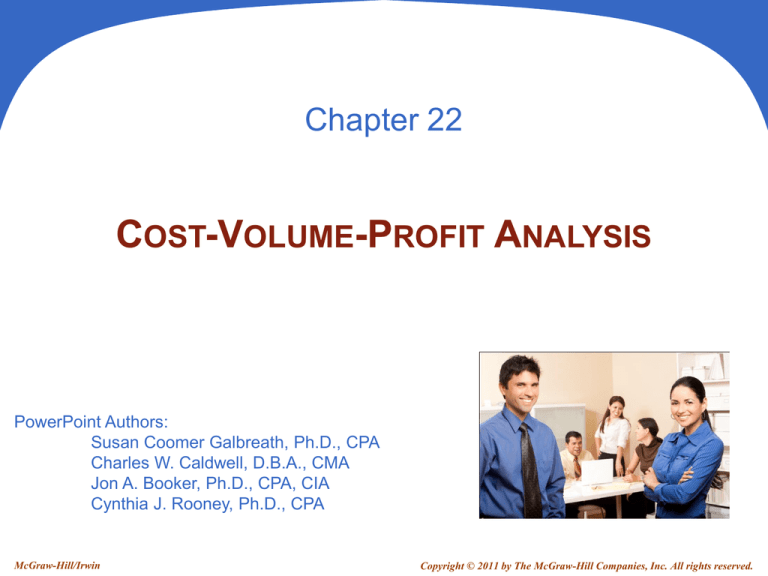
Chapter 22
COST-VOLUME-PROFIT ANALYSIS
PowerPoint Authors:
Susan Coomer Galbreath, Ph.D., CPA
Charles W. Caldwell, D.B.A., CMA
Jon A. Booker, Ph.D., CPA, CIA
Cynthia J. Rooney, Ph.D., CPA
McGraw-Hill/Irwin
Copyright © 2011 by The McGraw-Hill Companies, Inc. All rights reserved.
22 - 2
Number of Local Calls
Total fixed costs
remain constant as
activity increases.
Monthly Basic Telephone
Bill per Local Call
FIXED COSTS
Monthly Basic
Telephone Bill
C1
Number of Local Calls
Cost per call
declines as
activity increases.
22 - 3
C1
Total Costs
Cost per Minute
VARIABLE COSTS
Minutes Talked
Total variable costs
increase as
activity increases.
Minutes Talked
Cost per Minute
is constant as
activity increases.
22 - 4
C1
MIXED COSTS
Total Utility Cost
Mixed costs contain a fixed portion that is incurred even when
the facility is unused, and a variable portion that increases with
usage. Utilities typically behave in this manner.
Variable
Cost per KW
Activity (Kilowatt Hours)
Fixed Monthly
Utility Charge
22 - 5
P1
SCATTER DIAGRAMS
Draw a line through the plotted data points so that about
equal numbers of points fall above and below the line.
Total Cost in
1,000’s of Dollars
20
* ** *
**
* *
* *
10
Estimated fixed cost = 10,000
0
0
1
2
3
4
5
Activity, 1,000’s of Units Produced
6
22 - 6
P1
SCATTER DIAGRAMS
Δ in cost
Δ in units
Unit Variable Cost = Slope =
Total Cost in
1,000’s of Dollars
20
* ** *
**
* *
* *
10
Horizontal distance is
the change in activity.
0
0
1
2
3
4
Activity, 1,000’s of Units Produced
5
6
Vertical
distance
is the
change
in cost.
22 - 7
P1
THE HIGH-LOW METHOD
The following relationships between units
produced and total cost are observed:
Using these two levels of activity, compute:
the variable cost per unit.
the total fixed cost.
22 - 8
P1
THE HIGH-LOW METHOD
High activity level - December
Low activity level - January
Change in activity
Units
67,500
17,500
50,000
Cost
$ 29,000
20,500
$ 8,500
Variable cost per unit is determined as follows:
Fixed costs are determined as follows:
Total cost = $17,525 + $0.17 per unit produced
22 - 9
A1
CONTRIBUTION MARGIN AND ITS
MEASURES
Sales Revenue (2,000 units)
Less: Variable costs
Contribution margin
Less: Fixed costs
Net income
Total
$ 200,000
140,000
$ 60,000
24,000
$ 36,000
Unit
$ 100
70
$ 30
Contribution margin is the amount by which revenue
exceeds the variable costs of producing the revenue.
Total contribution margin is $60,000 and the
contribution margin per unit sold is $30.
22 - 10
A1
CONTRIBUTION MARGIN AND ITS
MEASURES
Sales Revenue (2,000 units)
Less: Variable costs
Contribution margin
Less: Fixed costs
Net income
Contribution
margin ratio
Contribution
margin ratio
Total
$ 200,000
140,000
$ 60,000
24,000
$ 36,000
Unit
$ 100
70
$ 30
=
Contribution margin per unit
Sales price per unit
=
$30 per unit
$100 per unit
=
30%
22 - 11
P2
COMPUTING THE BREAK-EVEN POINT
Sales Revenue (2,000 units)
Less: Variable costs
Contribution margin
Less: Fixed costs
Net income
Total
$ 200,000
140,000
$
60,000
24,000
$
36,000
Unit
$ 100
70
$ 30
How much contribution margin must Rydell Company
have to cover its fixed costs (break-even)?
Answer: $24,000
How many units must Rydell sell to cover its fixed
costs (break-even)?
Answer: $24,000 ÷ $30 per unit = 800 units
22 - 12
P2
COMPUTING THE BREAK-EVEN POINT
We have just seen one of the basic CVP
relationships – the break-even computation.
Fixed costs
Break-even point in units =
Contribution margin per unit
Unit sales price less unit variable cost
($30 in previous example)
22 - 13
P2
COMPUTING THE BREAK-EVEN POINT
The break-even formula may also be
expressed in sales dollars.
Break-even point in dollars =
Fixed costs
Contribution margin ratio
Unit contribution margin
Unit sales price
22 - 14
C2
COMPUTING SALES
FOR A TARGET INCOME
Break-even formulas may be adjusted to show the
sales volume needed to earn any amount of income.
Unit sales =
Fixed costs + Target pretax income
Contribution margin per unit
Dollar sales =
Fixed costs + Target pretax income
Contribution margin ratio
22 - 15
C2
COMPUTING SALES (DOLLARS) FOR A
TARGET NET INCOME
To convert target net income to before-tax
income, use the following formula:
Target net income
Before-tax income =
1 - tax rate
22 - 16
P4
COMPUTING A MULTIPRODUCT
BREAK-EVEN POINT
The CVP formulas can be modified for use when a
company sells more than one product.
The unit contribution margin is replaced with the
contribution margin for a composite unit.
A composite unit is composed of specific numbers of
each product in proportion to the product sales mix.
Sales mix is the ratio of the volumes of the various
products.
22 - 17
A2
DEGREE OF OPERATING LEVERAGE
A measure of the extent to which fixed costs are
being used in an organization.
A measure of how a percentage change in
sales will affect profits.
Contribution margin
Pretax income
= Degree of operating leverage
22 - 18
END OF CHAPTER 22








